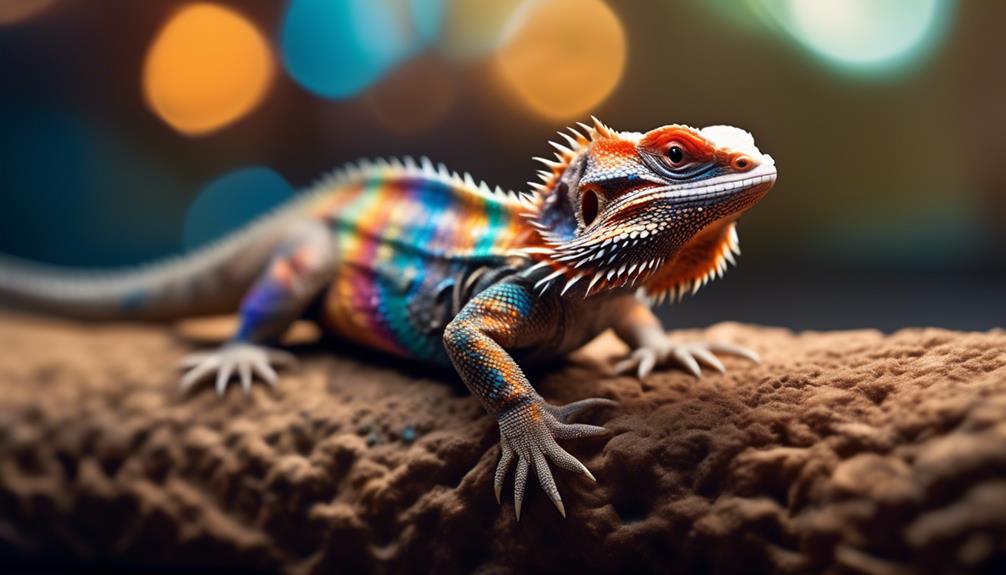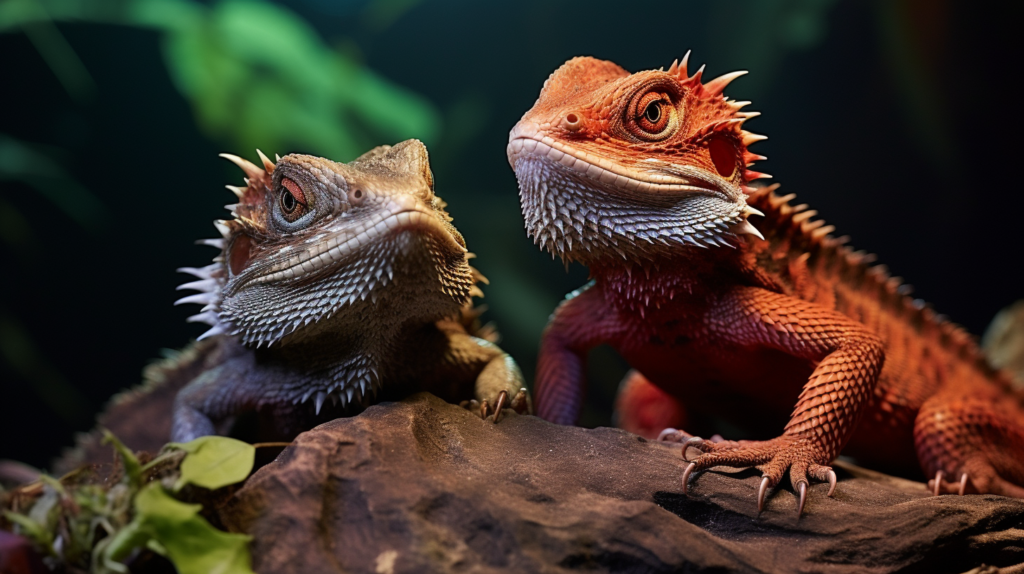You may have noticed the growing interest in the diverse world of bearded dragon morphs, particularly the captivating leatherback variety.
As you explore the intricate details of these unique creatures, you'll come to appreciate the stunning array of colors and patterns that adorn their scales.
But there's more to these morphs than meets the eye. Understanding the genetic traits that influence these variations is just the beginning of unraveling the fascinating world of leatherback bearded dragon morphs.
So, let's delve into this intriguing realm and unlock the secrets behind these mesmerizing creatures.
Understanding Leatherback Bearded Dragon Traits
The leatherback trait in bearded dragons results in a smooth back with spikes only on the sides and head, enhancing the dragon's color and affecting the scale texture to reduce water retention compared to standard morphs.
When it comes to understanding leatherback bearded dragon morphs, it's essential to comprehend their physical characteristics. The visual morphs of leatherback dragons are striking, with a smooth back and spikes concentrated on the sides and head. This unique trait not only enhances the dragon's color, making it appear more vivid, but also impacts the scale texture, reducing water retention compared to standard morphs. This reduction in water retention is significant, as it can impact the overall health and well-being of the dragon.
When considering the morphs of bearded dragons, the leatherback trait stands out for its distinctive visual zero, giving these dragons a solid color across their smooth back, with spikes concentrated on the sides and head. Understanding these traits is crucial for those serving these dragons, as it provides valuable insights into their care and well-being. By recognizing the specific characteristics of the leatherback morph, individuals can ensure the optimal health and happiness of these unique creatures.
Genetics and Breeding of Leatherback Morphs
Breeding leatherback bearded dragon morphs involves a detailed understanding of genetic terminology, as it plays a crucial role in determining their unique appearance and colors. When considering the genetics and breeding of leatherback morphs, there are essential factors to keep in mind:
- Recessive and Dominant Traits: Understanding the concepts of recessive and dominant traits is key. For instance, leatherback is a dominant trait, meaning if a dragon carries one leatherback gene, it will display the leatherback trait.
- Homozygous and Heterozygous: Knowing whether a bearded dragon is homozygous (having two identical genes for a particular trait) or heterozygous (having two different genes for a trait) is crucial in predicting the outcomes of breeding.
- Co-dominant Traits: Leatherback morphs can exhibit co-dominant traits, where both traits are fully expressed, leading to unique patterns and colors. Understanding how these traits interact is essential for successful breeding.
- Designer Morphs: Breeding for designer morphs involves specialized knowledge as it often requires combining specific single-gene morphs to achieve desired color and pattern combinations.
Understanding these genetic principles is essential for successful bearded dragon breeding. It not only allows for the prediction of potential offspring traits but also contributes to the responsible breeding of healthy and visually stunning leatherback bearded dragon morphs.
Identifying Different Leatherback Morphs
Identifying the different leatherback morphs requires a keen understanding of their distinct physical characteristics and scales, as well as an appreciation for the nuanced variations in their appearances. Each morph presents unique features that distinguish it from others. Below is a table outlining some common leatherback bearded dragon morphs and their identifying traits:
| Morph Type | Identifying Characteristics |
|---|---|
| Dunner Dragons | More scales than normal, pointed scales in different directions |
| Hypo Zeros | Solid black eyes, light color and pattern |
| Translucent | Highly translucent appearance, light coloring |
Dunner dragons, for example, have an increased number of scales and pointed scales that differ from the standard. Hypo zeros have solid black eyes and display light coloration and patterns. Translucent bearded dragons have a highly translucent appearance and light coloring. Recognizing these traits is crucial for accurately identifying the different leatherback morphs. Understanding these characteristics is also important for providing appropriate care, as different morphs may have specific care requirements. By being able to identify and understand the different leatherback morphs, you can better serve the needs of these unique and fascinating creatures.
Care and Maintenance of Leatherback Morphs
Understanding the specific care and maintenance needs of different leatherback morphs is essential for providing optimal health and well-being for these unique and fascinating creatures. Here are some essential care tips for maintaining leatherback bearded dragon morphs:
- Temperature and Humidity Regulation: Leatherback morphs require a basking area with a temperature range of 95-110°F to mimic their natural habitat. It's vital to maintain a humidity level of 30-40% to prevent dehydration, especially because leatherbacks are more prone to it.
- Nutrition and Supplements: Offer a varied diet consisting of appropriately sized insects and fresh vegetables. Dust the insects with calcium and vitamin supplements to ensure proper nutrition and prevent health issues like metabolic bone disease.
- Enclosure and Habitat: Provide a spacious and secure enclosure that allows for climbing and basking. A substrate such as reptile carpet or ceramic tile is ideal for leatherbacks as it prevents ingestion and eases shedding.
- Shedding and Bathing: Leatherbacks require more frequent shedding and bathing due to their smoother scales. Provide a shallow water dish for soaking to aid in shedding, and monitor their skin condition closely.
Health Considerations for Leatherback Dragons
To ensure the optimal health and well-being of leatherback dragons, it's crucial to carefully monitor their hydration levels and create a habitat that closely mimics their natural environment. Leatherback dragons are particularly susceptible to dehydration due to their reduced water retention capabilities. As a responsible owner, it's essential to provide regular access to fresh, clean water and ensure that the humidity levels in their habitat are appropriate for their needs.
When considering the health of leatherback dragons, it's imperative to pay close attention to their diet. A balanced diet for these dragons should consist of a variety of insects and fresh vegetables. Additionally, essential supplements such as calcium and vitamins are crucial to support their overall well-being. Proper nutrition is fundamental in maintaining their health and vitality.
Furthermore, it's important to be mindful of their shedding frequency and be prepared for the possibility of brumation, a period of dormancy similar to hibernation. This natural process requires specific care and monitoring to ensure the dragon's health and safety.
Frequently Asked Questions
What Is the Rarest Bearded Dragon Morph?
The rarest bearded dragon morph is the Purple/Blue, highly sought after due to its distinct coloring. Breeding challenges, genetic mutations, and market trends contribute to its rarity. Price and demand, along with conservation efforts, also play a role.
How Do You Tell if Your Bearded Dragon Is a Leatherback?
To tell if your bearded dragon is a leatherback, examine its skin texture, scale patterns, shedding process, heat tolerance, UVB light requirements, tail shape, claw length, eye color, body size, and behavior differences. These traits distinguish leatherbacks from other morphs.
What Colours Do Leatherback Bearded Dragons Come In?
Leatherback bearded dragons come in a range of colors, such as brown, gray, yellow, red, orange, and rare hues like blue, silver, and purple. Breeding possibilities and genetic inheritance contribute to the variety, making certain combinations popular.
What Is the Prettiest Bearded Dragon Morph?
The prettiest bearded dragon morph is subjective to personal preference. However, Leatherback, Silkback, and Translucent morphs offer unique patterns and vibrant colors, making them popular choices among collectors and enthusiasts in the morph market.
Conclusion
In the intricate world of leatherback bearded dragon morphs, one must navigate through the genetic labyrinth to uncover the hidden treasures of color, pattern, and size.
Just as a skilled navigator charts their course through uncharted waters, a diligent breeder must carefully select traits to produce the most exquisite morphs.
Careful consideration and research are essential to avoid the pitfalls of fake morphs, ensuring that only the purest and most authentic specimens are added to your collection.


